(Note: William Burckart and Steve Lydenberg are fellows of High Meadows Institute. This article is adapted from their new book, 21st Century Investing: Redirecting Financial Strategies to Drive Systems Change.)
What are the biggest threats to an investor’s portfolio these days? Climate change impacts all investors across all asset classes. Income inequality threatens to polarize politics, paralyze governments, destabilize democracies, and lead to nationalistic populism, trade wars and even geopolitical conflicts. Pandemics disrupt economic models and require heroic efforts by governments and private enterprise to keep system-wide collapse at bay.
These are the 21st century’s fundamentally destabilizing, new and different, social and environmental challenges. They are global. They have tipping points that once passed cannot be reversed. They are systemic risks in a highly interconnected and complex world. And they threaten long-term investment returns across all asset classes in ways that traditional risk management cannot cope with.
All of which leads to the big question: how are investors supposed to act on these systemic risks? Our new book, 21st Century Investing: Redirecting Financial Strategies to Drive Systems Change, provides an answer. The book, which lays out a roadmap for how investors can shift their investment practices to meet the challenges of our modern times, is based on the work we have been doing for the past six years with our team at TIIP (The Investment Integration Project), a consulting services and applied research firm.
The big idea at the center of the book—and our work generally—is that investors need to better understand and act on the big picture context of their investments, and the feedback loops between their investments and the planet’s overarching systems that make profitable investment opportunities possible; we at TIIP have coined the term “system-level investing” to describe this challenge.
We have worked with investors and others since we founded TIIP to create and strengthen a burgeoning system-level investing movement. 21st Century Investing provides the what, why, and how of system-level investment: what it means to manage system-level risks and rewards, why it is imperative to do so now and how to integrate this new way of thinking into current practice. The six key elements of that process are the same for all investors: set goals, decide where to focus, allocate assets, apply investment tools, leverage advanced techniques and evaluate results. For each step along the way, we illustrate the need for and benefits of incorporating a system-level perspective.
Take an issue like climate change. A conventional investor may see this problem as an opportunity, not a threat, investing in oil drilling in a rapidly melting Arctic or metals mining in Greenland as its icecap recedes. Sustainable investors would keep their portfolios “clean,” divesting from fossil fuel companies or adding wind and solar power firms to their portfolios.
System-level investors, however, approach this challenge in a more holistic way. They build a portfolio of companies devoted to solar energy, wind power, battery storage, next-generation energy efficiency, sustainable forest products, regenerative agriculture and the like that can provide a holistic vision of what an alternative world could be.
And they do not stop there, but participate in calls for mandatory disclosure on greenhouse gas (GHG) emissions so they can make intelligent investment decisions, join with their peers in global collaborative efforts like Climate Action 100+, create new markets for climate-friendly investment products like “green bonds” and support the setting of voluntary and government-backed standards for what defines those markets.
They also urge trade associations not to work against their members’ calls for climate action; they support regulatory measures that promote the development of climate-friendly industries through subsidies, tax abatements, preferential purchasing programs, carbon pricing or taxes, and the like; they look for leverage points within systems that can catalyze change; they set goals at a system level and measure their progress toward those goals.
This system-level approach is evident in the work of the New Zealand Superannuation Fund (NZ Super), a sovereign wealth pension fund in New Zealand, which has used a diversity of approaches to address climate change. Not only did NZ Super incorporate climate change into its asset pools, but it promoted this framework to other sovereign wealth funds. NZ Super saw the double-benefit of encouraging other wealth funds to do the same.
System-level investors also seek to promote, and demonstrate models for, such changes across all industries in, for example, a particular asset class, creating customized, multi-industry indexes embodying those changes. Among those using this system-level technique for climate change are the California State Teachers’ Retirement System (CalSTRS). Launched in 2017 with a $2.5 billion commitment, its Low-Carbon Index is made up of stocks in all industries in all markets (U.S., developed and emerging) around the world. CalSTRS’s goal is for these holdings to have reduced carbon emissions and reserves in each market by between 61% and 93% in the coming years.[1] Since passive index funds hold hundreds, if not thousands, of stocks across all industries, the CalSTRS index will paint a picture of what the future should look like in all companies around the world, in effect setting a benchmark and model for the environmental performance of large corporations on climate change.
By paying attention to the feedback loops between investment practice and social, financial and environmental systems, system-level investors can set goals that contend with threats that conventional and sustainable investing often ignore. In doing so, these investors acknowledge their impacts on the economy as a whole, their responsibility for stewardship of systems that have been built up over decades, centuries, and eons, and their ability to create long-term value, pursue profit with a purpose and set social norms. This is a challenge, but one that can be overcome by those adopting a new mindset and the right techniques.
William Burckart and Steve Lydenberg’s book, 21st Century Investing: Redirecting Financial Strategies to Drive Systems Change, is available to order here.
[1] The California State Teachers’ Retirement System (CalSTRS), Green Initiative Task Force: Annual Report Ending June 30, 2019 (California: CalSTRS, 2019), 43.

